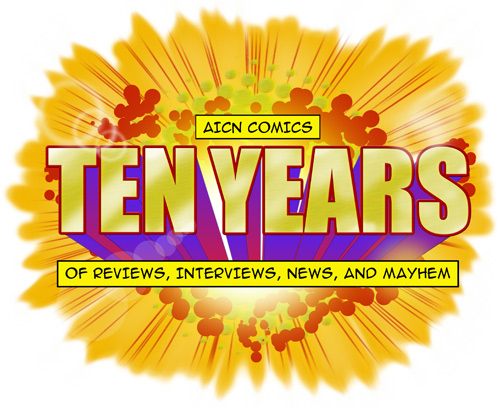
| Issue #33 | Release Date: 11//9/11 | Vol.#10 |
(Click title to go directly to the review)
Advance Review: JUSTICE LEAGUE #3
THE SIMON AND KIRBY LIBRARY: CRIME HC
30 DAYS OF NIGHT #2
CAPTAIN VICTORY #1
HOUSE OF NIGHT #1
TALL TALES FROM THE BADLANDS #1
ULTIMATE COMICS SPIDER-MAN #4
FLASH GORDON: INVASION OF THE RED SWORD #6
Advance Review: ELEPHANTMEN #36
AICN COMICS Podcast!
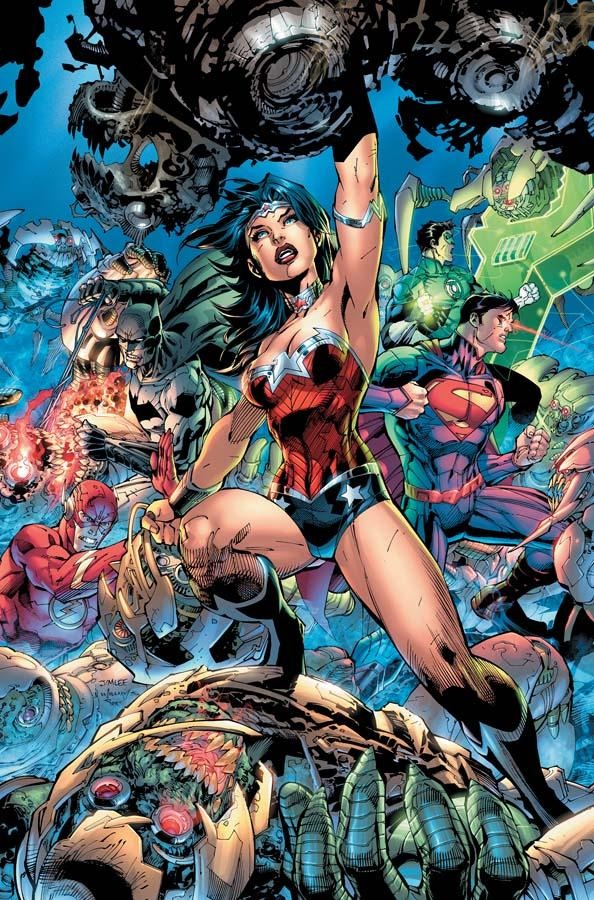 Advance Review: In stores today!
Advance Review: In stores today!JUSTICE LEAGUE #3
Writer: Geoff JohnsArtist: Jim Lee
Publisher: DC Comics
Reviewer: Optimous Douche
I see followers of this column in a much different light than the average collector. You are a breed of readers that, like us, look for the deeper meaning in comics. There are a million sites where you can glean the obligatory plot points of this issue; things like the nanites being injected into Victor Stone’s body to complete his transformation into Cyborg, the banter between Barry and Hal as they both try to call dibs on newcomer Wonder Woman, the appearance of Aquaman as Darkseid’s base of operations Boom Tubes out of the sea to dwarf even the tallest of earth’s skylines. This issue was a tsunami of action save the opening of Wonder Woman discovering the heavenly delights of ice cream. Again, if you truly require a blow-by-blow replay of every page my feelings won’t be hurt by clicking off this page. What I want to talk about is what this new JUSTICE LEAGUE symbolizes and perhaps unearth the polarity of fandoms’ loving or loathing for this cornerstone of the new DC universe.
Good comics always reflect the age we live in. The new JUSTICE LEAGUE is a picture-perfect mirror of our age of disillusionment. I sat reading JUSTICE LEAGUE as my local Philadelphia news bombarded my senses in the background with a scandal that has rocked one of our most revered institutions and continues to descend our angels of mercy into the plane of mortal fallible men. Some may still want their heroes to be perfect, but I hold no delusions. I simply can’t and consider myself a rational human being. And it’s for that reason alone I can appreciate this new JUSTICE LEAGUE and their less than perfect ways. Some have not been able to swallow this hard pill; they still want their heroes to be dipped in 24 karat gold, shit rainbows and always make the right decisions. Those people have my deepest condolences, because the world has moved past them. Thank God for back issues, I guess.
When the first issue of JUSTICE LEAGUE hit the shelves in 1960, the world was a much smaller place. A world where our exposure to media consisted of newspaper columns and an hour of news that was broadcast into the one black & white television that sat inside the average American’s home. There was no 24 hour news cycle, no Internet to feed confidential documents into the belly of the wikileaks beast and then have that information regurgitated into the mouths of millions. In short, our heroes of that age were protected; they could hide their dirty secrets because there was no TMZ hiding outside the bushes to take snap shots of their fetishes or dirty deeds done dirt cheap. The JUSTICE LEAGUE of yore was perfect because we perceived our real world heroes to be perfect as well. Take the top real world hero of the time: JFK. He was a man that was revered as a savior for America raising our aspirations into the heavens and attempting to bring the American dream to all citizens of this country, not just the white folks. But even in death JFK could not escape this new age of transparency. In the fifty years since his assassination news of backroom deals to get elected, dalliances with Hollywood starlets and even rumors of a pain pill addiction have been brought into the “light.” JFK wasn’t perfect; we merely didn’t have the resources or the channels when he was alive to uncover the more morally objectionable facets of the man. Superheroes, as the name implies, serve to embody an ideal greater than real world heroes. So if we extrapolate my JFK example it stands to reason that the comic book characters of the time would shine like gilded platinum being directly illuminated by the light of God.
Now, comics took a dark decent in the 80s with the likes of Moore and Miller. Granted, we could blame M&M as just being dark people, but there have been dark people before and our collective do-goodness forced those people into the shadows. Instead, though, we drank in these titles and allowed them to forever transform the comic medium. Why did we allow it? Because it was in lockstep with the dark pall covering the real world. A President had fallen a decade prior, Iran-Contra was smudging the tarnish of the anointed Ragan and Jim Baker was dipping into the holy hole of his secretary. No, these weren’t the first guys to do bad things, but this was the first time that their fallacies were being exposed in real time to the American public. I was a wee Douche during this time period and like most children I was completely impressionable. I revered Miller’s Batman as a hero despite his brutality. I viewed the Watchmen as heroes despite their fetishes or pining for human connection even in the face of denying their duty. I knew even then that no one, and I mean no one, is always 100% good or without flaws.
So we come to today. The internet has been rife with criticisms of Superman’s reckless abandon in ACTION, Hal Jordan’s seeming misstep in characterization as more brawn than brain and the deifying of villains in SUICIDE SQUAD and DEATHSTROKE. Do we blame DC for these characterizations? Yes, some do, but I don’t. I look at it from the broader perspective; I realize that I’m an aging comic fan and there is a generation after me that grew up without any exposure to the supposed “age of innocence” that will be the lifeblood of this medium moving forward. Comics and the ideal of the heroes therein must speak to this audience that is far more steeped in cynicism, scrutiny and insistence on seeing all sides of a person’s life, not just the heroic small snippets of time that were presented in comics of old.
Some misdeeds like we are seeing at Penn State right now do negate the good, but not all misdeeds should be weighted equally. A young Superman causing a few more bruises than prior iterations does not obliterate the fact this man spends all of his free time trying to serve the greater good. DC chalks up the inexperience of this new JUSTICE LEAGUE to the fact that we are looking at a world from five years ago. As any adult knows, though, five years is an infinitesimal amount of time. People do not change the core of their being in a mere five years once we leave childhood. I say this new JUSTICE LEAGUE is a reflection of our current view of heroes. No one, not even heroes, live on a pedestal anymore and if they do, we desperately search for the dark recesses. If we can’t find these dark tides of the soul we turn our backs because our fiction is only believable when it reflects reality.
Optimous has successfully blackmailed fellow @$$Hole BottleImp into being his artist on Average Joe. Look for Imp's forced labor on Optimous brain child in mid-2011 from COM.X. Friend Optimous on FaceBook to get Average Joe updates and because ceiling cat says it's the right thing to do.
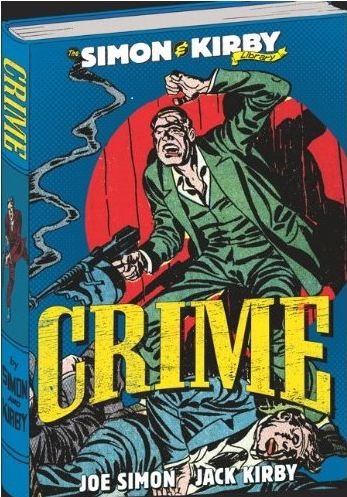
THE SIMON AND KIRBY LIBRARY: CRIME HC
Writer: Joe SimonArt: Jack Kirby
Publisher: Titan Books
Reviewer: superhero
Ahhhh, the Golden Age. The goofy, goofy Golden Age. It’s hard to believe at times that anyone really could have taken some comics seriously during that era. It’s hard to believe that certain comic books got some shrinks and parents riled up so badly that there was a call for regulating the whole industry. While it’s true that I’ve seen some comics from that era that I would definitely think twice about handing over to a child, a lot of what I’ve seen from that era just seems like very naïve and innocent fun.
That’s pretty much how I would classify the stuff in THE SIMON AND KIRBY LIBRARY: CRIME. The comics in this book are a blast but there’s nothing in here that I would consider hard edged or gritty comics story telling. If you’re looking for that sort of thing you’re not going to find it here. THE SIMON AND KIRBY LIBRARY: CRIME is a catalog of late 1940’s to early 1950’s comics that may have been shocking at the time that they were published but might seem extremely tame or outrageously silly to modern day readers. These comics are crime stories, it’s true, but I’ve seen crime comics from the Golden Age that make these seem like Saturday morning cartoons for the most part.
That isn’t to say that these comics aren’t entertaining in their own right. I actually loved the stories in this book. I’d just want to warn readers of books like 100 BULLETS, Ed Brubaker’s CRIMINAL series, or even Darwyn Cooke’s PARKER comic adaptations that the kind of sort of realistic edgy crime comics that those series represent are not what you’re going to get in this book. What you do get is a collection of fantastically rich and entertaining gangster, “true crime”, romance, and historical comics that just ooze with the charm of the era that they were created in. I absolutely loved the comics in here because of their straightforward simplicity. There is absolutely no subtlety to these comics and it’s wonderful. It’s just straight on villainous fun from the first panel mixed in with imaginative and silly circumstances. It is stuff that’s not meant to be taken seriously…at least I don’t think it was meant to. I mean, one of the very first stories in the book has a gumshoe called Gunmaster trying to track down a guy who can only drink goat’s milk because he’s accursed with a rare disease that has left Element X in his body…one of three compounds that enemies of the United Nations seek to use for their evil purposes! Another story involves a killer shooting people with a rigged up wooden leg in order to help solve the world’s overpopulation problem.
Yeah, it’s ridiculous stuff--but Simon and Kirby are such geniuses at their craft that they make stories that should be so off the wall unbelievable work like gangbusters. And for every goofy or silly idea that they float across the pages of this book there are other more straightforward tales of criminal woe. There are stories of mobsters, serial killers, gun molls, traitorous lovers and crazed historical figures. There’s a definite reason that these comics are considered classics, and it’s because they transcend the limitations of what their creators were allowed to do within the confines of a comic book of that period. Despite the somewhat dopey tropes of the Golden Age of comics these crime tales are able to entertain in the modern day because of the strength of their creators’ abilities and conviction to do justice to the books they were working on. Kirby’s art (while being a long ways away from his classic Marvel style) is impressive and filled to the brim with a manic glee that not a lot of other Golden Age comic artists could capture. Each page barely can contain the crackling energy of Kirby’s talent. THE SIMON AND KIRBY LIBRARY: CRIME is a cornucopia of Simon and Kirby greatness.
It would be unfair of me to close out this review without mentioning what a great job was done on putting this book together. Editor Steve Saffel and Art Restorer/Colorist Harry Mendryk should be commended on the supreme quality of their work on this book. Titan Books has always been a class act when it comes to their collected editions and THE SIMON AND KIRBY LIBRARY: CRIME is no exception. It is a welcome companion to THE SIMON AND KIRBY SUPERHEROES and should be placed on every comic geek’s Christmas list this holiday season.
Discovered as a babe in an abandoned comic book storage box and bitten by a radioactive comic fan when he was a teenager, superhero is actually not-so mild mannered sometime designer & cartoonist, Kristian Horn of Los Angeles, California. Some of his work can be seen at www.kristianhorn.com and check out his blog at www.parttimefanboy.com. You can check also out his webcomic at www.babybadass.com, which is currently in development.
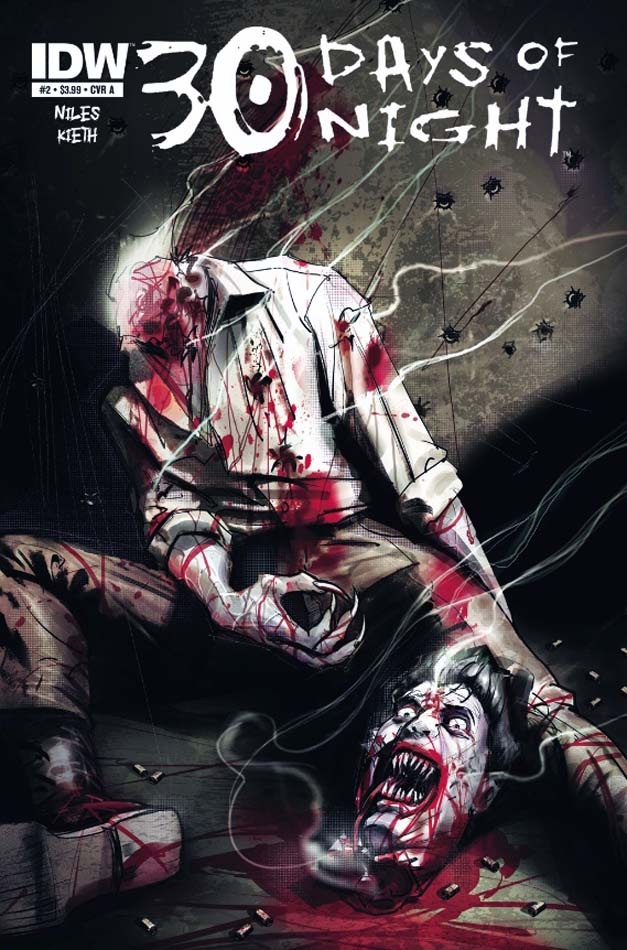
30 DAYS OF NIGHT #2
Writer: Steve NilesArtist: Sam Kieth
Publisher: IDW Publishing
Reviewer: Lyzard
I’ll read or view anything involving vampires. I was introduced to 30 DAYS OF NIGHT through the 2007 film version. After that I picked up the original Steve Niles and Ben Templesmith series, eventually buying 30 DAYS OF NIGHT: BEYOND BARROW, illustrated by Bill Sienkiewicz. More recently I watched 30 DAYS OF NIGHT: DARK DAYS and also enjoyed how Spike’s DEADLIEST WARRIOR: VAMPIRES VS. ZOMBIES had the style of vampires Niles and Templesmith created. So could you say I’m a fan of the 30 DAYS OF NIGHT? Does that really even need to be questioned?
According to the first issue of this new run, the “Story so far…Years following a vicious vampire attack on Barrow, Alaska, the reverberations can still be felt as far off as sunny Los Angeles, where a curious woman known as Alice Blood attempts to find proof of the existence of vampires.” Ambush Bug already reviewed this issue and I do agree with his assessment that “…it’s as good a time as any to show the grungier side of vampirism” and Sam Kieth continues the high standard of artwork that Templesmith set with the first few runs.
To catch up those who did not read the first issue, there are only four phrases that need to be said: “A mysterious letter…a vampire civil war…a curious woman…a deadly confrontation.” There you go, all caught up now. Alice Blood is in an alley, just having watched her newest acquaintance get his neck ripped out by a vampire. After taking down the monster, Alice Blood is left with a choice: save Dean from turning in to the very creature that killed him or turn in the first live vampire specimen to the F.B.I.?
While the first issue had several focuses, 30 DAYS OF NIGHT #2 is all about Alice Blood. For the most part the story is linear and without ellipsis. I don’t miss our letter sender from Barrow or the Benedict Arnolds of the vampire world, but I do hope they pop up again soon.
If you didn’t read the first issue in this run, then upon reading the second you would think that the vampires are essentially the same as in the 30 DAYS OF NIGHT film. The bloodsuckers you encounter in issue #2 are rage-filled monsters who prefer biting to talking. What I enjoyed so much about the first issue was that I finally got to see vamps use their tongues in more ways than just licking the blood off their lips. I would have liked to see the vampire that Alice Blood encounters have a few witty quips and retorts towards her. In the ongoing debate about what is better, a vampire or a zombie, I always favor the vampire due to their intelligence. Being taciturn generally is not seen as a sign of higher brain function.
I’ve never read or watched 30 DAYS OF NIGHT to cheer for the humans. I have followed the series to see those who are truly on top of the food chain massacre them. All that being said, the human characters of this run are interesting and Niles has created empathy for them. Still, I cannot wait to see these characters that he has made us care for go up against a group of hungry nosferatu. I may like Alice Blood, but I’d also like to see her live up to her name and be bled out.
Lyzard is actually Lyz Reblin, a senior screenwriting major with an English minor at Chapman University. Along with writing for AICN, she has been published twice on the subject of vampire films.
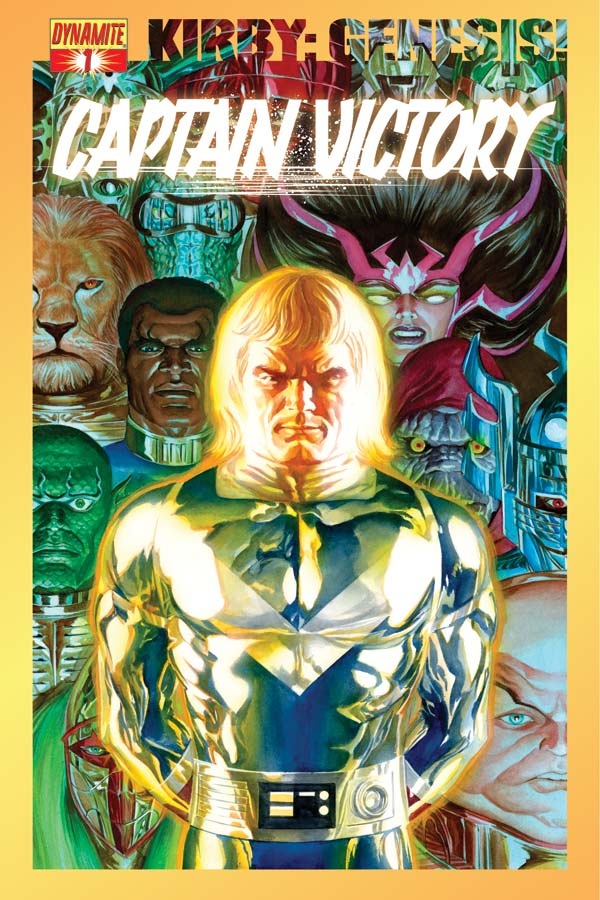
CAPTAIN VICTORY #1
Writer: Sterling GatesArtist: Wagner Reis
Publisher: Dynamite Entertainment
Reviewer: Professor Challenger
“When you get to the gates of Hell, stand there and wait for my grandfather. I'll send him along soon enough.” – Capt. Victory
I really was disappointed in this one. I love Kirby's work on CAPT. VICTORY AND THE GALACTIC RANGERS, but I sure didn't care for this comic.
The story, such as it is, begins with Capt. Victory (think Orion of the New Gods) being resurrected in a new cloned body moments after being killed in a battle (think Battlestar Galactica Cylons). There's some fighting, a flashback sequence to give us a taste of the hard defining moments in Victory's life that have led to his thirst for battle, and then they are called back by Galactic Command. A little teaser bit about his evil and powerful grandfather Blackmass (think Darkseid), and the issue is done and the stage is set for the series.
Why it didn't work for me is a combination of the writing and the art. The writing just didn't grab me and interest me in the story or the characters and the art was distracting on a number of levels. Victory himself comes off pretty poorly to me, barking orders here and there. The other Rangers are pretty much ciphers with no real effort made to introduce them to me. Had I not some buried memories of who these characters were from my youth, then I wouldn't have had a clue...nor would I have cared.
I don't know if Alex Ross laid out the visual storytelling thumbnails, but I doubt that he did. As opposed to the GENESIS series, this suffers by really poorly structured pages, angles, and compositions. Superficially, the main figures usually bear the details well when they are super-hero-like with the heightened musculature. In those moments, they have a Brent Anderson quality to them that is fine. Unfortunately, the story calls for a lot of technological backgrounds and lots of figures wearing bulky sci-fi body armor and that's when the art really falls apart. The fault on this is something I lay on Dynamite's decision to obviously shoot from artist Wagner Reis's pencils rather than bring in someone to actually ink them. Not everyone's pencil art holds up to direct reproduction and nearly all the flaws in the art could have been fixed with a strong inker to clean up the scratchy lines and fix the inconsistencies in geometric angles and foreshortening.
The body armor moments are embarrassing. They look in no way like something a person could actually wear and the geometry of the armor is all over the place, which makes the panel compositions almost impossible to decipher at times.
I know there's a school of thought these days that persists in perpetuating a myth that “inks” in the past were simply a way of making the line art able to be photographed for reproduction. That may have been how it was in the beginning, but beginning in the 60s, there was a generation of artists committed to inks only that did much, much more than trace the pencils. These artists came in and tightened the art up. They fixed those angles, they cleaned up the lines, they added shadows and texturing. In other words, they collaborated with the pencil artist to create something together that was greater than what either of the artists could produce alone. This was especially true in some instances where an inker could pick up the slack when a penciller came up short in anatomical or geometric accuracy. This comic is one that was desperately crying out for an inker to step in. The main figures are so different in quality from the rest of them that they almost, at times, look like they are pasted down on top of the art – like they were done separately and then added in. It is very odd and made the entire comic difficult to follow.
I wanted to like this one. Unfortunately, it's just mediocre at best and that's just not good for a Kirby concept like this one. This should be rocking my world.
Prof. Challenger was beloved by many, despised by a few, but always lived his life to the fullest. Never did he miss an opportunity to pet a puppy, kiss a pretty girl, or ignore a hobo. He is survived by a long-suffering spouse, 2 confused children, a ridiculously silly dog, and a pompous fat old cat. The things that brought him happiness in this life were his comics, his books, his movies, and string cheese. Had he passed from this plane of existence, he would expect the loss to the world to be severe. As it is, however, he has not passed and has no plans to pass for quite awhile. So visit his website at profchallenger.com and read his ramblings and rantings and offer to pay him for his drawrings. He will show his appreciation with a winning smile and breath that smells like the beauty of angels.
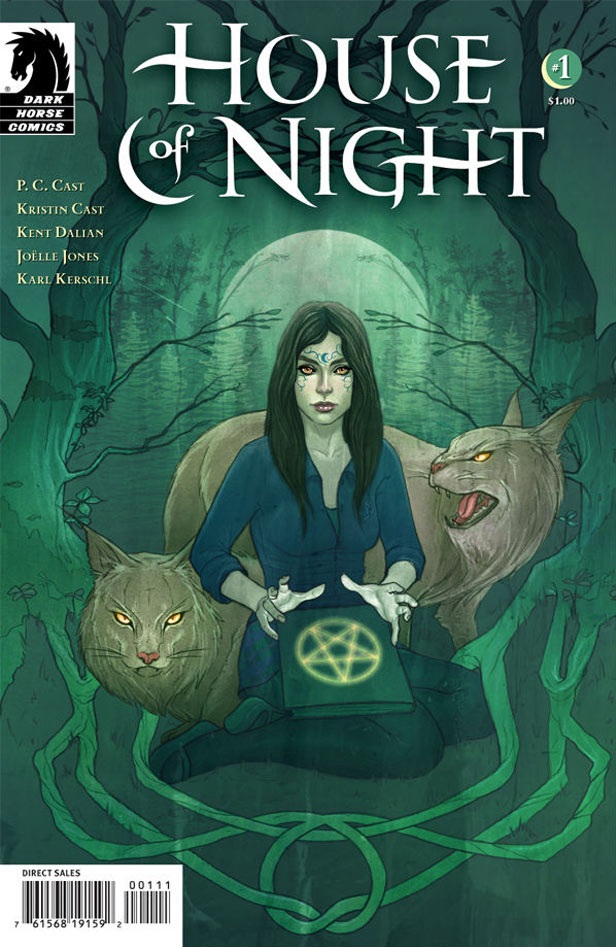
HOUSE OF NIGHT #1
Writer: PC CastArtist: Joëlle Jones, Karl Kerschl
Publisher: Dark Horse Comics
Reviewer: Optimous Douche
Thematically it’s easy to bemoan HOUSE OF NIGHT. Yes, it is another vampire book. Yes, we’ve all been overloaded with this mythology. And yes, vampire purists are sure to shed blood tears over yet another new iteration of the mythos. Personally, I want to drive a stake through the heart of anyone that bitches about a book based on abstracts alone.
In actuality there haven’t been any new stories since the bible, and let’s be honest even the big B probably wasn’t wholly original, just the first time we had an indelible way of passing forward folklore. So where most say “Groan, not another vampire book,” I take the approach of looking at whether it’s a good comic and story regardless of the mythological bucket it belongs in.
And HOUSE OF NIGHT is a damn good story. This is exactly what I would expect from the love child of Judy Blume and JK Rowling. Replace Margaret and Harry with Zoey Redbird, a girl who is trying her best to grow up as normally as she can while being the “chosen one” inside a school for vampires. I specifically chose two young reader authors for my comparison because HOUSE OF NIGHT sinks its fangs directly into that glorious vein of entertainment that works on different levels appealing to both teens and adults. I would have never had the chutzpah to traverse the tween section of Borders to read the prose that inspired this comic, but since comic shops are filled with man-children like yours truly this is a great way to imbibe good storytelling without sullying sections of retail outfits clearly not meant for someone born in the 1970s. HOUSE OF NIGHT proves beyond the shadow of a doubt that anyone who says that comics are no longer for “kids” simply isn’t looking hard enough. There are all the trappings that young people are currently dealing with and old fogies can remember with the gratitude that these trials and tribulations are behind us. Zoey has her group of supporters, but with that comes the inevitable detractors. In Zoey’s case, her chief rival is her own misgivings about her ability to lead other vampires after she is anointed the chosen one. Her secondary rival is a particularly bitchy vampire named Aphrodite that was the queen mean girl of popularity before Zoey arrived.
There’s a surprising lack of blood in HOUSE OF NIGHT considering it’s a vampire novel, but I appreciated the fresh originality of not drowning in each page in a sea of red. Cast avoids the copious amounts of the red stuff by giving her vampires the desire to live amongst humans so nary a drop is shed unless it is consensual between the vampire and their buffet. Cast also scores originality points by giving each vampire a tether to some elemental force (think earth, wind and fire – probably water as well, I just have an immediate affection for disco). And with the introduction of these forces is where the book truly takes off, in my humble opinion. Once we get over the establishment of Zoey’s place in the school and the teen sociology therein, we learn that Zoey is so special because she can control all of the elements where lesser vampires are only gifted with the ability to manipulate one.
Zoey and her friends choose to find solace in their outcast status by traversing stories about vampires of yore. In this particular instance the students decide to focus on the goddess of the winds. This is a true turning point in the book from both a story and art perspective. The western manga style of the time at school is replaced with a Warcraft-type feel as artist and writer traverse to the ancient lands of the Norse. Kerschel paints some beautiful snow covered vistas as Cast shows the first hands of friendship between normal folks and vampires.
Not having read the HOUSE OF NIGHT books, there’s little doubt that I’m missing a slew of subtle nuances to this inaugural comic chapter. I’ve been to enough comic book based movies with non-fans to realize that one line can carry huge meaning to those that have seen the futures (or past depending on your temporal reference) of these characters. However, as a new reader I found enough rich story detail, differentiation from all the other vampire stuff out there and amazing artwork to definitely want to set up residence in the HOUSE OF NIGHT.
Optimous has successfully blackmailed fellow @$$Hole BottleImp into being his artist on Average Joe. Look for Imp's forced labor on Optimous brain child in mid-2011 from COM.X. Friend Optimous on FaceBook to get Average Joe updates and because ceiling cat says it's the right thing to do.
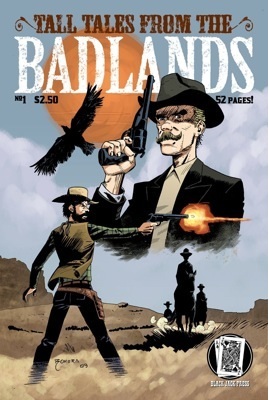
TALL TALES FROM THE BADLANDS #1
Writers: Sean Fahey & Seamus Kevin FaheyArtists: Lisandro Estherren, Jose Holder, J.C. Grande, Juan Romera & Borja “Borch” Pena
Publisher: Black Jack Press
Reviewer: BottleImp
So Ambush Bug saunters into my corner of the @$$hole offices one day, tosses this comic on my desk, and says “This ought to be up your alley—I know you like anthologies.” Then before I can say a word, he’s gone. I look at the cover and inwardly groan. See, I do have a fondness for the anthology comic and the short story format. But I have no love for the chosen genre of TALL TALES FROM THE BADLANDS: The Western. I’ve never been a fan of old Western movies, I never read Louis L’Amour or any Jonah Hex stories…even in the case of “The Twilight Zone”—one of the best anthology-format television shows of all time—I always lose interest once I see a ten-gallon hat or hear the jingling of a set of spurs. The prospect of wading through a collection of “cowboy stories” was dispiriting, to say the least. But then I read the forward by David Weddle (a writer and producer on such television shows as “Battlestar Galactica” and “CSI”), which made an interesting point about this genre: “…the science fiction genre…is so similar to the Western. Both forms feature characters crossing vast distances far removed from the institutions of civilization, often thrust into primal moral dilemmas in which they cannot call on a higher authority for guidance. They must make existential choices to decide who they are, what they stand for, what their values are.” Now, I love science fiction, but had never made that simple connection between the thematic elements of the outer reaches of time and space and the stripped-down existence of the Wild West. I resolved to put aside my prejudices and give this comic my undivided attention, and boy, am I glad I did. ‘Cause I can say without hyperbole that TALL TALES is one of the finest anthology comics that I have ever read.
“Thicker Than Water” written by Sean Fahey, art by Lisandro Estherren
The anthology opens with its best story, an exploration of the bonds of family and of friendship. The reader travels with Nathan Miller, a bank robber who has escaped the gallows and saved his brother’s family from murder by turning his partner in crime in to the authorities. Torn between the desire to keep his family safe and his feelings of guilt, Nathan promises to deliver his partner’s last letter to his sister as a way of making amends for his betrayal. This wasn’t the stereotypical shoot-em-up Western that I had come to expect from the genre; this story is a deeper look at the emotional connections that drive our actions. And just when this chapter was winding up into what looked like a satisfying, if somewhat placid, conclusion, Fahey threw in a twist that actually made me gasp out loud as I read it—no joke! The script is perfectly complemented by Estherren’s stylized artwork, a mixture of solid masses of blacks and whites along with scratchier hatched lines. The overall effect conveys both the hot, bright desert sun and the gritty feel of this rougher and wilder era.
“Abigail” written by Seamus Kevin Fahey, art by Jose Holder
This next tale eschews the more melancholic, philosophical musings for a straightforward, slam-bang action story. As her husband rides with a posse to track down a dangerous criminal, Abigail is left alone with her children to fend off a vicious attack from a pack of bandits. It’s a frantically paced sequence that could stand toe to toe with any Hollywood action flick, with the largely dialogue-free story told through Holder’s loose and expressive inking. My one nit to pick here is that at times the panels become a little hard to decipher as the linework becomes loose to the point of being scribbly, making the action unclear. But on the whole, the artwork effectively conveys the intensity and ferocity of the plot.
“The Runt” written by Sean Fahey, art by J.C. Grande
Why is it that cartoon animals can be some of the saddest things in the world? This chapter is one such example, the simple, silent story of a mangy dog doing its best to protect its master from the assault of the wild. The fact that the dog’s master is already dead just adds an extra layer of pathos. You know what? This is a good one, but let’s move on…*sniff*… to something a little less tragic.
“A Thousand Deaths” written by Seamus Kevin Fahey, art by Juam Romera
An old gunslinger faces yet another showdown as he ponders the inevitability of his own demise in this story. Much like “Thicker Than Water,” the focus is on the internal drive of the character rather than the exterior action, making for a moody and introspective look at this hoary Western cliché. The story is capped off with a clever twist that lets the reader off with a touch of levity. Romera’s artwork here is superb; his panels are cinematic in their stark simplicity and use of light and shadow—I’m reminded of Harvey Kurtzman’s work on the “serious” EC titles of the 1950s; Romera shares that sensibility of keeping the flashiness to a minimum while achieving maximum storytelling impact.
“Easy Livin’” written by Sean Fahey, art by Borja “Borch” Pena
The TALL TALES anthology comes to a close with a look at the life of those who opened up the American West to further exploration and settlement, focusing on a fur trapper living out in the wilderness with little but his rifle, traps and a dog. No surprises or twist endings here, but a well-told slice-of-life that displays this rough time in America’s history with a touch of nostalgia for simpler times, but manages to do so without ever feeling cloying or overly sentimental. The artwork here is probably the best in the anthology; Pena’s graceful linework and carefully applied gray tones evoke the classic work of Alex Toth while retaining the artist’s own modern sensibilities. The final page, in particular, is beautifully rendered and a perfect way to close out this issue.
So thank you, Ambush Bug, for forcing me to overcome my prejudices and re-examine my preconceptions regarding this classic, quintessentially American genre. If any readers out there share in those feelings, I encourage you to do as I did and take a chance on TALL TALES OF THE BADLANDS. You just might end up rethinking your stance on the Old West.
When released from his bottle, the Imp transforms into Stephen Andrade, an artist/illustrator/pirate monkey painter from New England. He's currently hard at work interpreting fellow @$$Hole Optimous Douche's brainwaves and transforming them into pretty pictures on AVERAGE JOE, an original graphic novel to be published by Com.x. You can see some of his artwork here.
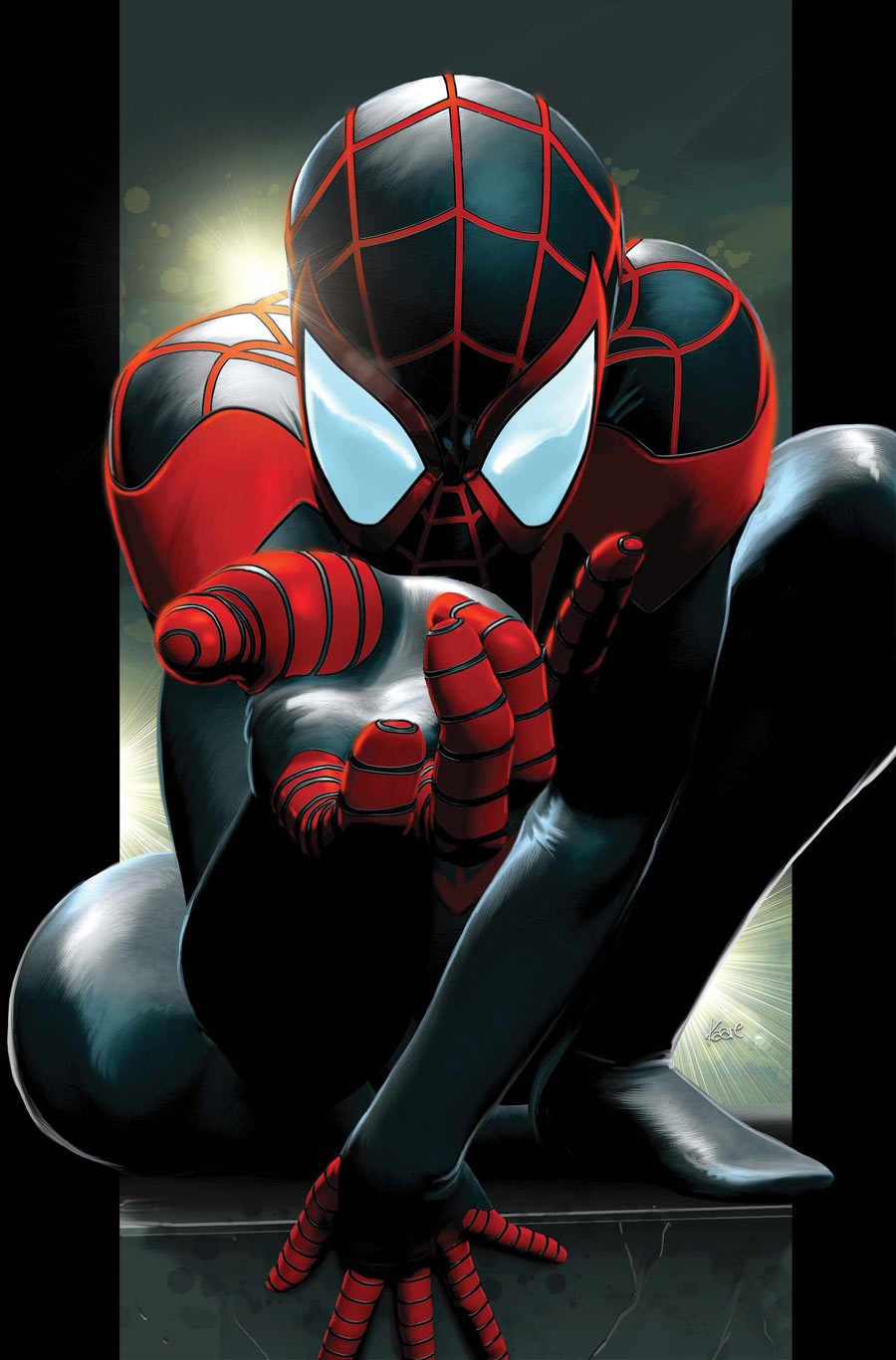
ULTIMATE COMICS SPIDER-MAN #4
Writer: Brian Michael BendisPencils: Sara Pichelli
Colors: Justin Ponsor
Publisher: Ultimate Marvel
Reviewer: Johnny Destructo
Ah-HA! I friggin' called it! Ahem. Sorry. This issue was awesome just like every other issue of this series was awesome. There's your review. Go buy it and come back, because SPOILER ALERT.
When all the hubbub of Peter's death and a new Spidey taking over the mantle was swirling around the toilet that is the internet, I kept saying that the best way to make this work would be for new Spidey to feel guilt over Peter's death.
"I really hope that this new Spider-Man had the ability to save Pete from dying, but didn't, and will become Spidey because of that mis-step, much like Pete learned from his irresponsibility and the death of Uncle Ben."
I even went back and poured over the issue where Pete bit it and looked for characters in the background who could take over the mantle.
"Wouldn't that be cool, if they drew in the character in the background? That'd be so cool!"
Clearly, I was geeking out. But can you blame me? ULTIMATE SPIDER-MAN has consistently been my favorite Spidey-title since it appeared in 2000. Bendis has crafted a nearly flawless series that has lasted for 11 years now, and it's always good! This issue is, of course, more of the same. Miles has gotten wind that Spider-Man has been shot and is fighting the Green Goblin, and rushes to the scene to help, but gets there a moment too late. He actually IS in the crowd as Peter dies in Aunt May's arms and even talks to Gwen as she sobs on the lawn. I was glad that my hypothesis was on point, but I have to say, I really think Marvel dropped the ball on what could have been a really cool Easter Egg for the fans. As I said, I did go back months ago and check the backgrounds to see who was in the crowd, and then did so again last night, knowing the Miles was actually there…but alas, there was no sign of him. And yes, yes, of COURSE this is me being nit-pickety, but if they knew all this time how it was going to go down, they should have drawn Miles into the background. Or hell, he's wearing a blue and red track jacket. Bagley could have just drawn a dark silhouette with hints of blue and red, if they were afraid of showing the new character too soon. This is just me being silly, though.
Miles also visits the Funeral Of Peter Parker from ULTIMATE FALLOUT and again engages Gwen, trying to understand why Pete did the heroic things he did. I love this scene and how real it feels. The unencumbered curiosity of a young boy without the sense to know when it's appropriate to ask certain questions. He's just curious and asks. It reminded me just how young Miles is. He's a sidekick's age, but without the hero mentor to guide him. I hope that Gwen shows up and becomes a side character. I'd like to see more of her helping out, and it would be a nice link between the old Spidey cast and the new one.
We also get a revisit of Miles' tangle with The Kangaroo, also from ULTIMATE FALLOUT, and the behind-the-scenes for that little jaunt. And what finally shows up? The inner monologue of Spidey's that you just know Bendis loves to write. Toss in a guest appearance at the end, and you have a pretty perfect Spider-Man comic.
There is absolutely NOTHING to dislike about this book. If you're holding off just on principle, you're missing out on something amazing.
JD can be found hosting the PopTards Podcast, drawing a weekly webcomic, discussing movies, comics and other flimflam over at www.poptardsgo.com, graphically designing/illustrating for a living, and Booking his Face off over here. Follow his twitter @poptardsgo. His talkback name is PopTard_JD.
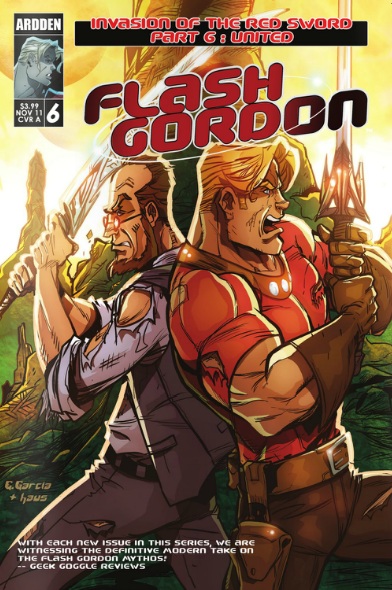
FLASH GORDON: INVASION OF THE RED SWORD #6
Writer: Brendan DeneenArtist: Eduardo Garcia
Publisher: Ardden Entertainment
Reviewer: Professor Challenger
“So....Hans...when we met at that boring dinner after the Olympics, did you ever think we'd end up like this?!” -- Flash Gordon
A rousing conclusion to a great story. I've raved about Ardden's FLASH GORDON series every chance I get and the conclusion to this mini-series is perfect. I don't want to give anything away, but all the pieces come together in a very satisfying wrap-up (and, like all good serials, a tease about an obvious future development). If I understand correctly, the next FLASH GORDON series from Ardden is not going to be a monthly pamphlet-style but a complete story in one larger graphic novel format.
I understand the market needs that make that the more viable way to get the story out there, but I will miss the serialized aspect of the monthly series. One of the hallmarks of this and the previous mini-series have been the masterful pacing and cliffhanger-style storytelling.
I can't really dig into it much deeper other than to say that I love the way writer Brendan Deneen writes the characters. They are recognizable as Flash and his supporting cast but they feel modern and relevant. The story is fun but also nuanced with moments given to characterization. Artist Eduardo Garcia stepped in with this story and has grown with each issue. He gets better and better. A fine artist with a good sense of how to tell the story in pictures.
Recommended for all ages.
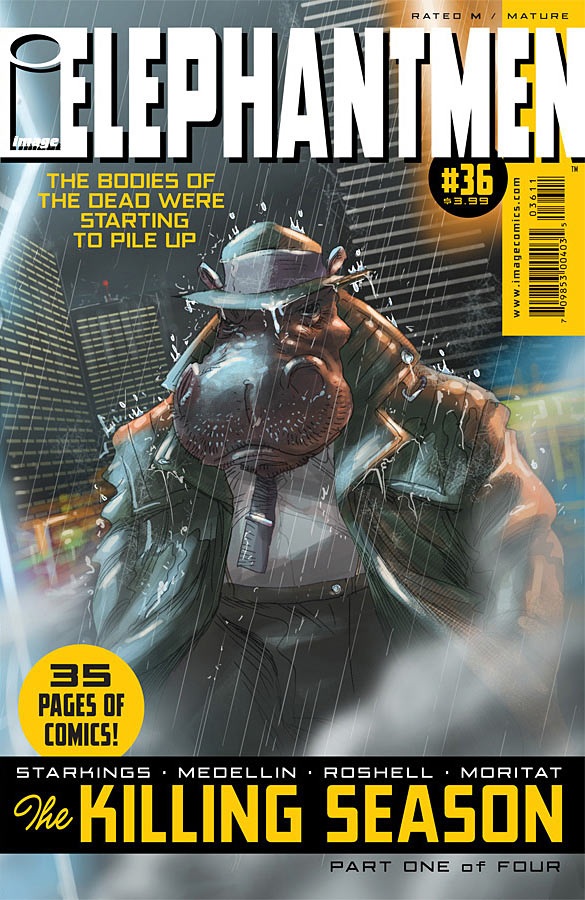 Advance Review: In stores today!
Advance Review: In stores today!ELEPHANTMEN #36: THE KILLING SEASON Part 1 (of 4)
Writer: Richard StarkingsArt: Axel Medellin
Publisher: Image Comics
Reviewer: MajinFu
Set two hundred years from now, in a future where genetically modified human-animal hybrids walk among us, ELEPHANTMEN is a tale that has revolved around themes of crime, sex and murder, with philosophical underpinnings and ethical questions also firmly in place. Despite the numerous anthropomorphic characters this one is obviously not for kids, but for more mature readers looking for a hardboiled noir story with a sci-fi twist (think “Blade Runner” meets “The Island of Dr. Moreau”).
In a grim beginning to the new arc entitled “The Killing Season” this issue opens with a flashback to seventeen years earlier that sets the tone for the story. A facility housing genetic hybrids of humans and animals has been discovered by a group of armed humans and things turn ugly pretty fast. Richard Starkings’ knack for dialogue is immediately apparent, as we follow the chaos and trauma inflicted by the humans who are given distinct personalities in a matter of two or three pages. The story then shifts to the present, where Hieronymous “Hip” Flask, the hippo detective, has been called in to investigate another murder somewhere in futuristic Los Angeles. Elephantmen are apparently dying at an alarming rate and nobody can find the killer. This is a story that is obviously much bigger than a simple murder mystery, but while this issue is merely laying the groundwork for what’s to come, it does so exceptionally well thanks to some compelling character work and good visuals. Axel Medellin does an excellent job of capturing the gritty animalistic qualities of many of the characters while presenting a future metropolis that is smooth and shimmering.
The issue’s sub-title, “Day Before Yesterday”, refers to the rhythmic use of flashback throughout the issue, as past events come back to haunt the present and we are introduced to the conflicts of not just one, but several characters. The rest of the issue is about the business tycoon/rhino Obadiah Horn and his human fiancé Sahara. Most of the story’s philosophical musings also come into play as they are visited by Gabbatha, the elephant Buddhist. All of it is presented in a very clear art style with liberal use of spread pages, primarily to convey the size and scope of the Elephantmen, who are illustrated with an eye for creating sympathetic, emotional characters that still look intimidating.
The book has interspecies relationships that are handled with care and attention to the fragility of human emotions, even through the eyes of the Elephantmen. There is sex, but it’s handled tastefully and thankfully most of it is left to the imagination since what is really important is the later ramifications--which brings me to Hip’s human girlfriend Miki, who I didn’t find particularly likable. After Hip leaves her to go the murder scene, we follow Miki on her daily trip to work. I honestly found her sequence to be the weakest of the book, although it did offer a nice contrast to all of the gruesome murders. The story jumps around a lot from one character to another but it never gets confusing or hard to follow. In fact, any readers who have had any remote interest in this series will be glad to hear this issue makes for a great jumping on point.
ELEPHANTMEN is a complex series with a lot going for it, including some stunning futuristic visuals, a surreal dystopian future setting, and a wide range of characters and motivations that make for a compelling murder mystery. Did I mention this issue’s cliffhanger will leave you waiting with bated breath for the next issue? There is a dramatic tension and a lingering sense of foreboding I get from this book. It’s really solid work that has me looking forward to the next issue, if only to see what happens next.
AICN COMICS PODCAST #3
Looks for more of the Holes rambling about comics on Poptards in future AICN COMICS columns!
Proofs, co-edits & common sense provided by Sleazy G
Check out AICN COMICS on Facebook and Comixpedia.org!

